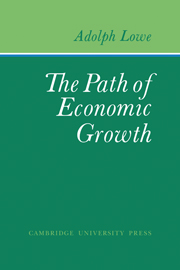Book contents
- Frontmatter
- Contents
- Preface
- Acknowledgments
- PART I The Basic Model
- PART II Changes in the Rate of Change
- PART III Changes in the Rate of Change
- PART IV Changes in the Rate of Change
- 21 The Scope of the Investigation
- 22 Dynamic Equilibrium Once More
- 23 Nonneutral Innovations: A General Survey
- 24 Pure Labor-Displacing Innovations
- 25 Pure Capital-Displacing Innovations
- 26 Some Comments on Combined Changes in the Input of Labor and Capital
- 27 Technical Progress and Diminishing Returns
- 28 Some Concluding Remarks
- Appendix: An Alternative Presentation of Lowe's Basic Model
- Glossary of Recurring Symbols
- Name Index
- Subject Index
23 - Nonneutral Innovations: A General Survey
Published online by Cambridge University Press: 07 October 2011
- Frontmatter
- Contents
- Preface
- Acknowledgments
- PART I The Basic Model
- PART II Changes in the Rate of Change
- PART III Changes in the Rate of Change
- PART IV Changes in the Rate of Change
- 21 The Scope of the Investigation
- 22 Dynamic Equilibrium Once More
- 23 Nonneutral Innovations: A General Survey
- 24 Pure Labor-Displacing Innovations
- 25 Pure Capital-Displacing Innovations
- 26 Some Comments on Combined Changes in the Input of Labor and Capital
- 27 Technical Progress and Diminishing Returns
- 28 Some Concluding Remarks
- Appendix: An Alternative Presentation of Lowe's Basic Model
- Glossary of Recurring Symbols
- Name Index
- Subject Index
Summary
Because neutral innovations are characterized by “an equal rise of productivity on the part of all labor however far back or forward it may be between the inception and the final stage of production,” they assure constancy not only of the capital-output ratio but also of the level of utilization of capital and labor. Now, nonneutral innovations change the relative application of the two resources. Therefore one might expect that the nature of nonneutral change is reflected in characteristic changes of the capital-output ratio.
Indeed, in the literature the proposition has been advanced that a fall in the capital-output ratio indicates “capital-saving” and its rise, “labor-saving.” However, such a sweeping generalization arouses suspicion simply because it fails to take notice of the great variety of possible combinations of the two factors, to which reference was made earlier. Nor is it ever made clear whether the proposition concerns the initial impact on the innovating firm, industry, or sector or the terminal capital-output ratio for the system at large, after the initially “saved” factor has been brought back into utilization. Moreover, where in one of the equipment-good sectors are we to place a labor-“saving” innovation that reduces the replacement costs of secondary equipment and, thus, resembles capital-“saving” in the consumer-good sector?
From all this it follows that, to be able to read a particular type of nonneutral innovations in any indicator, we must, first of all, rigorously define the concepts of labor-saving and capital-saving.
- Type
- Chapter
- Information
- The Path of Economic Growth , pp. 246 - 255Publisher: Cambridge University PressPrint publication year: 1976



